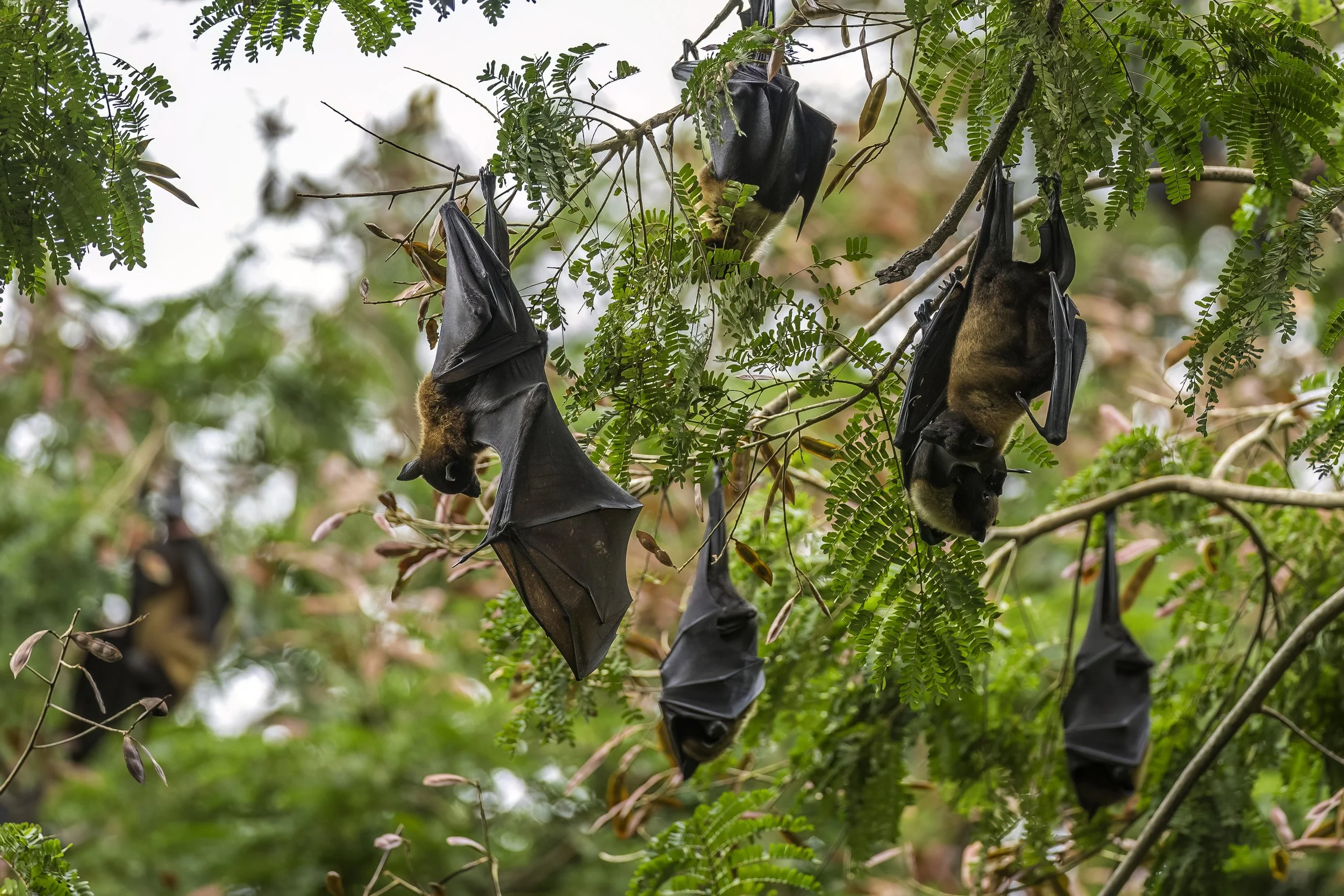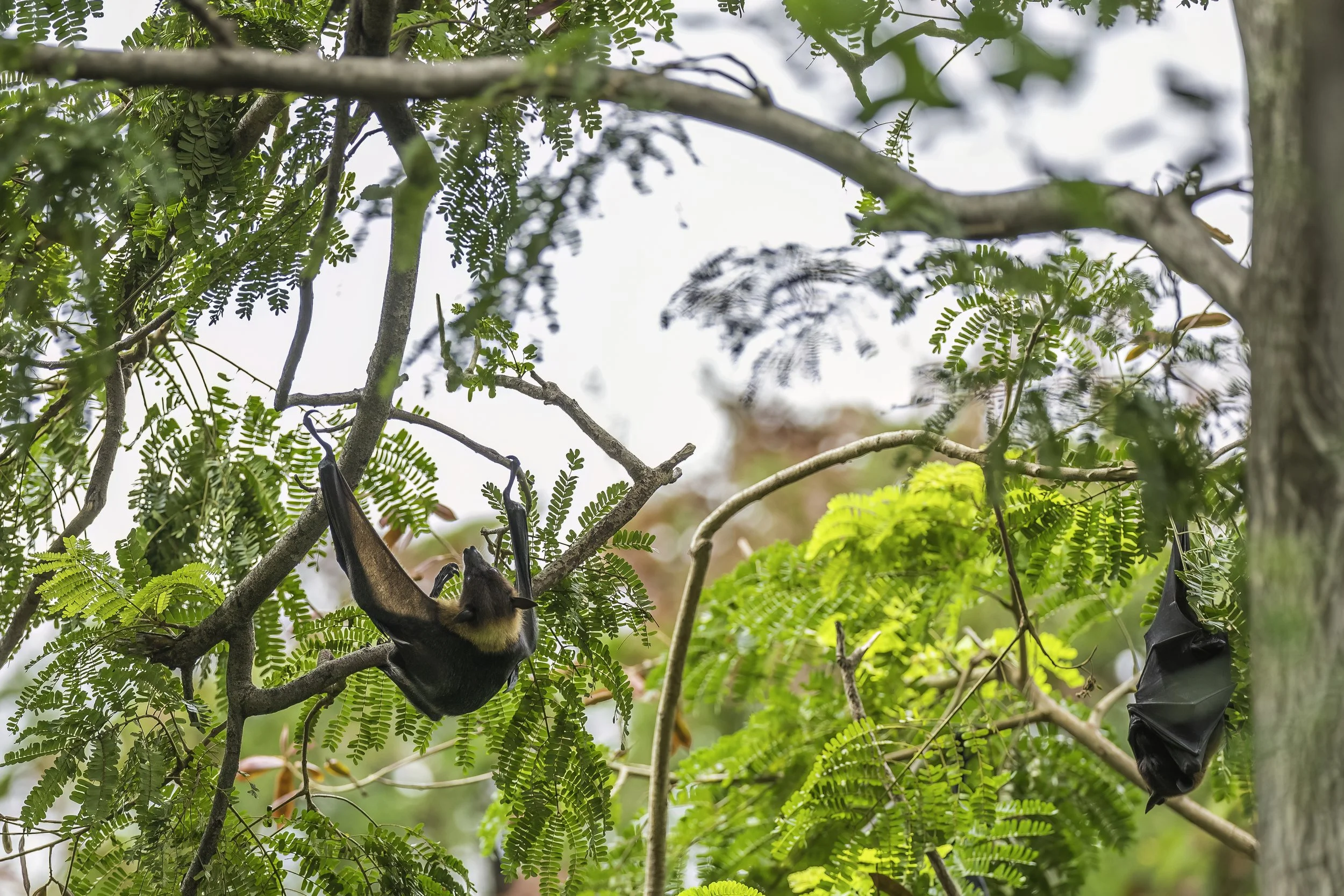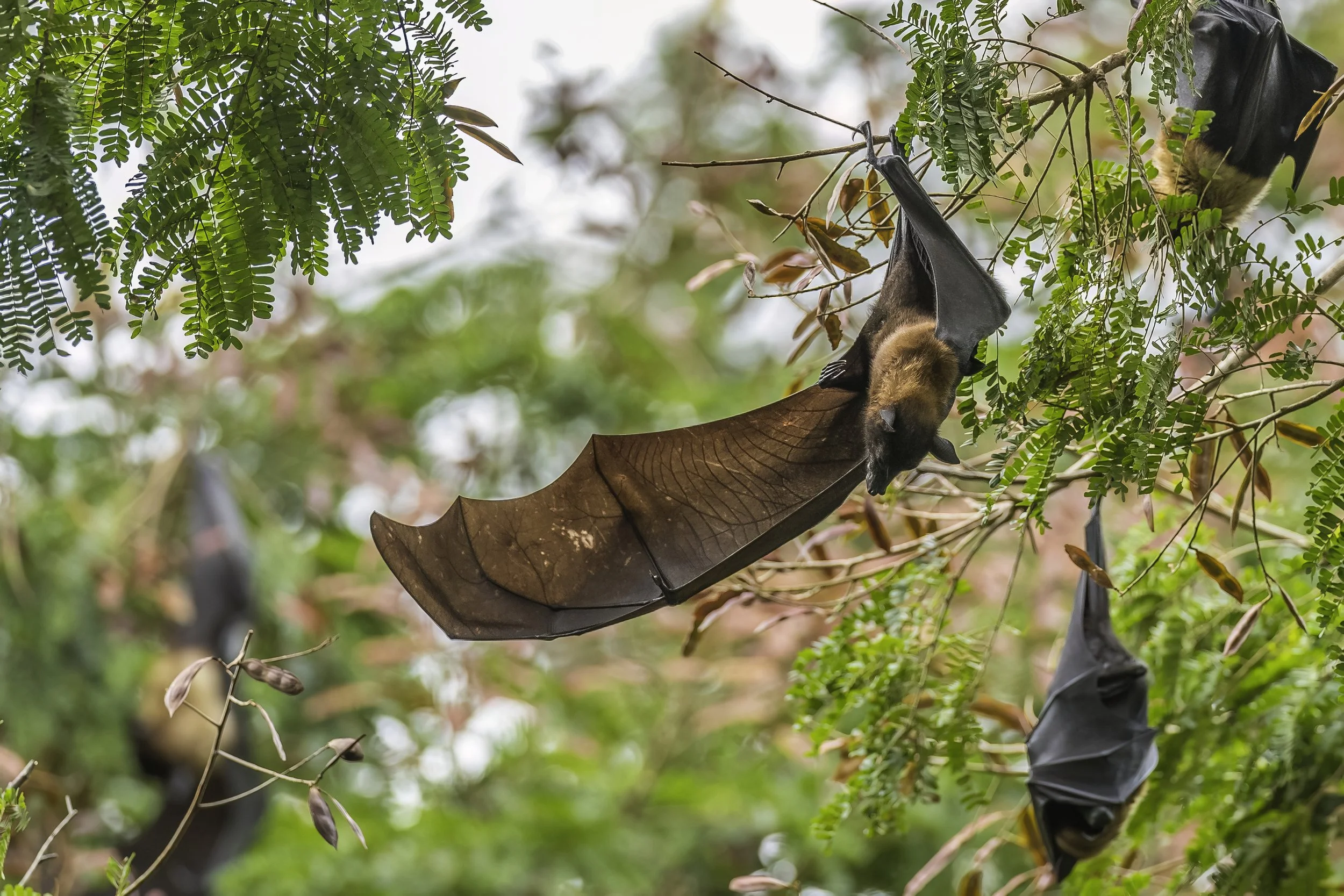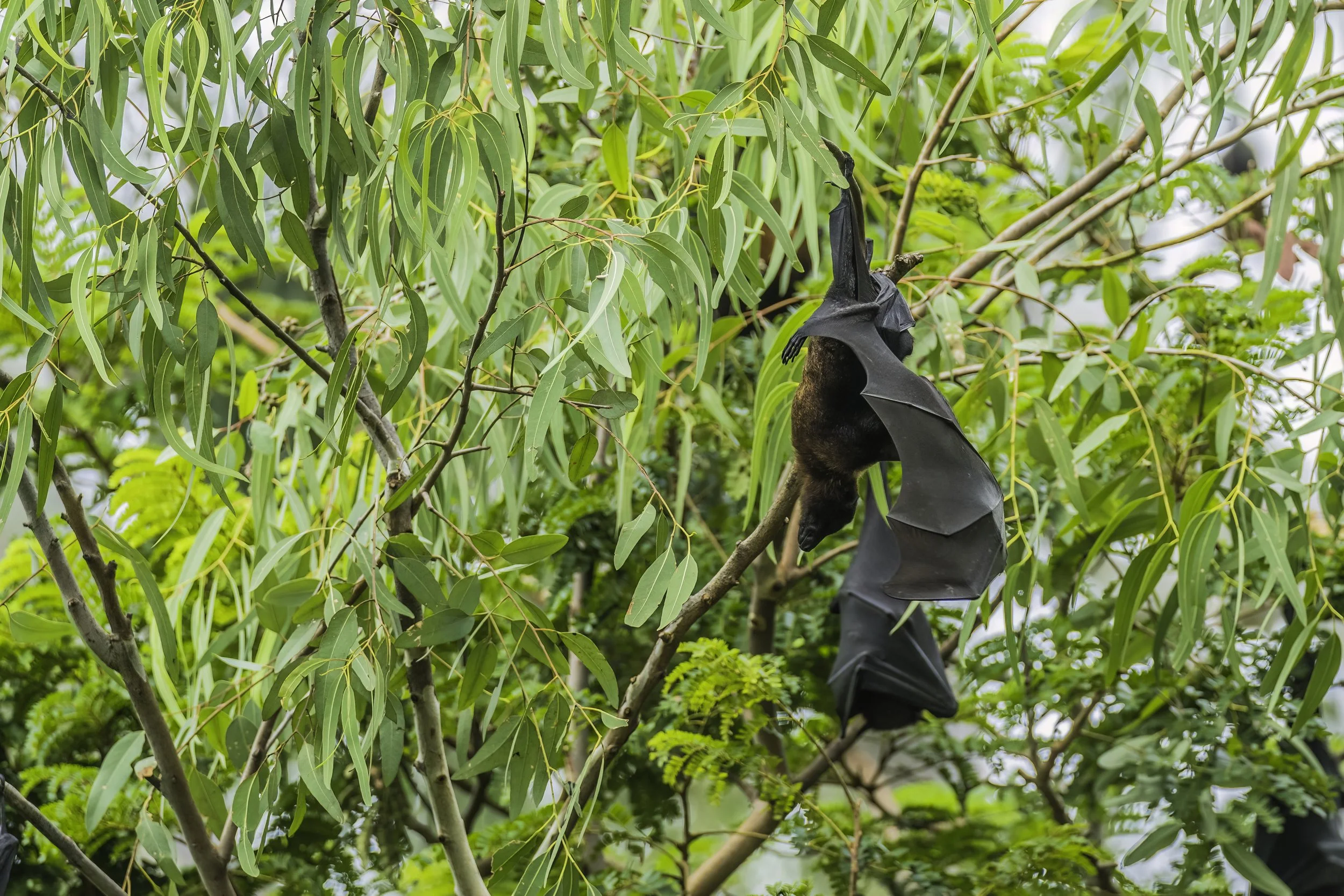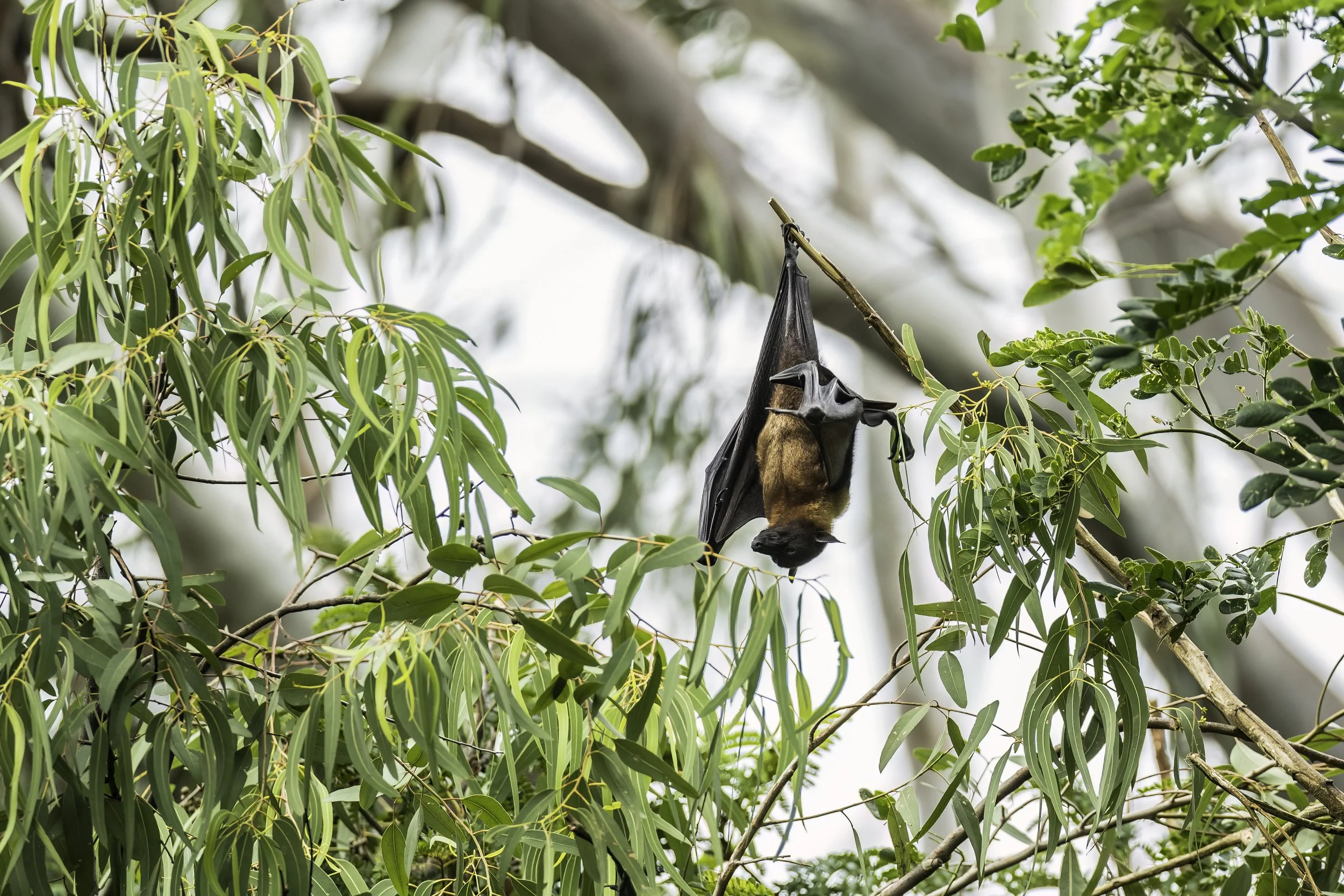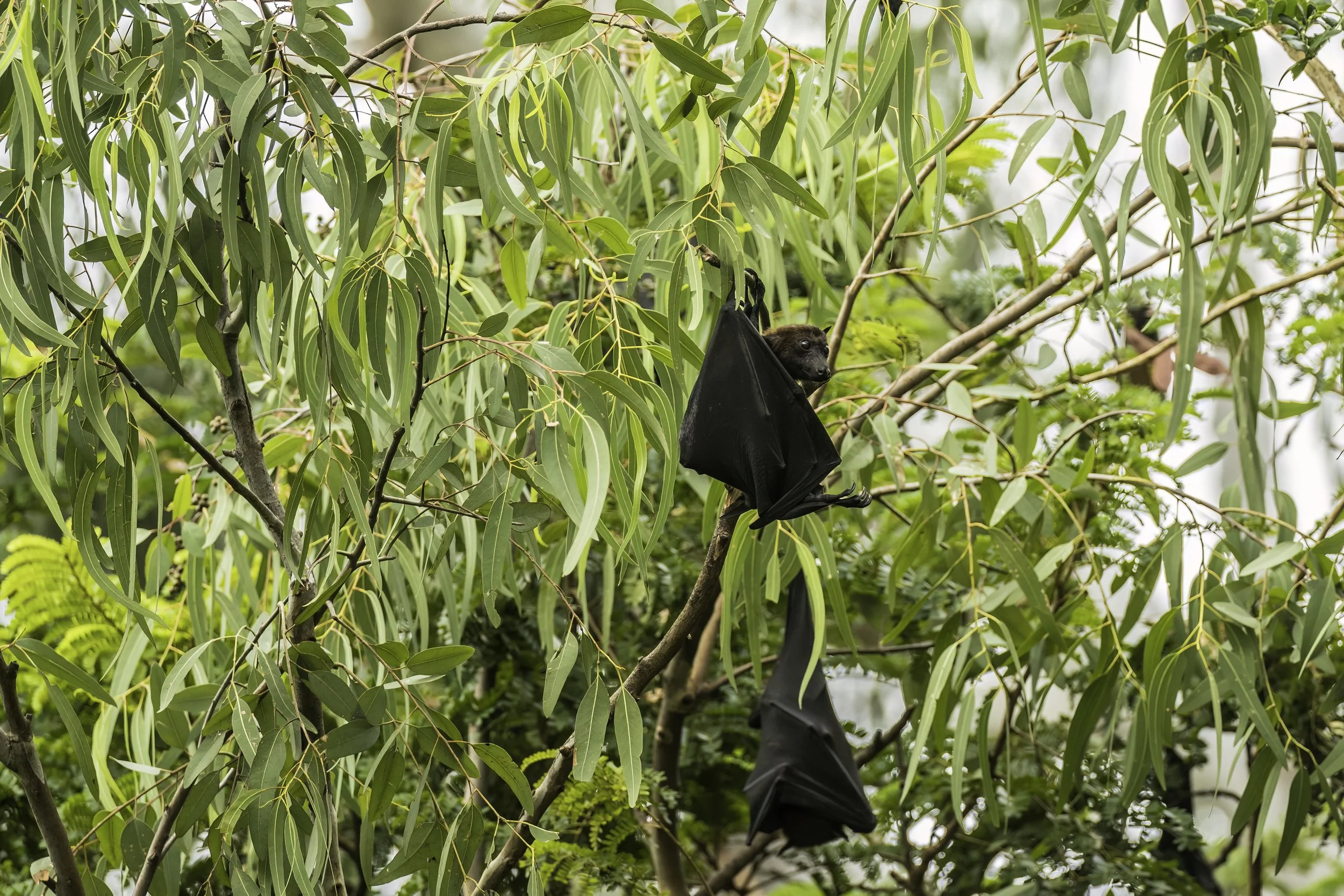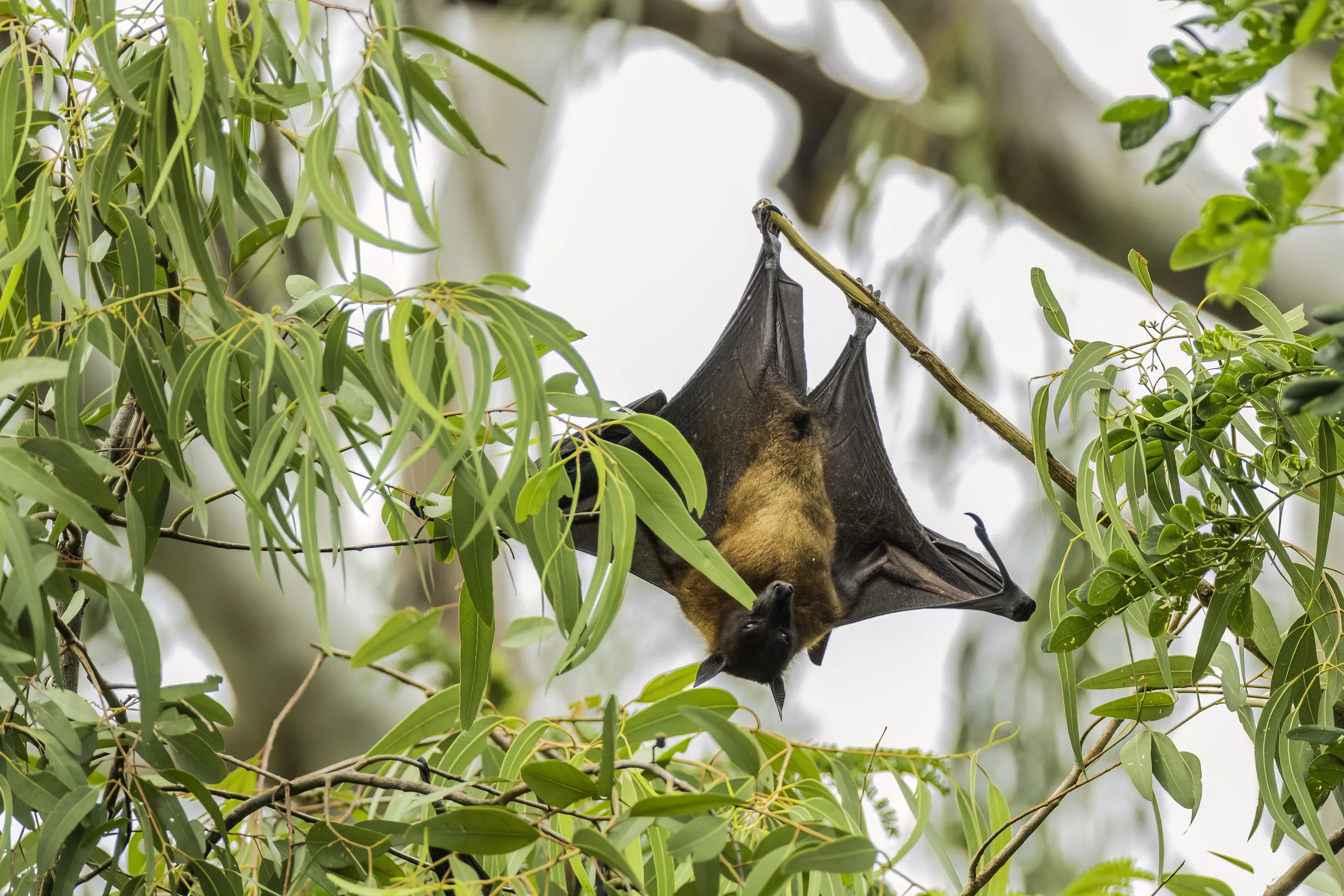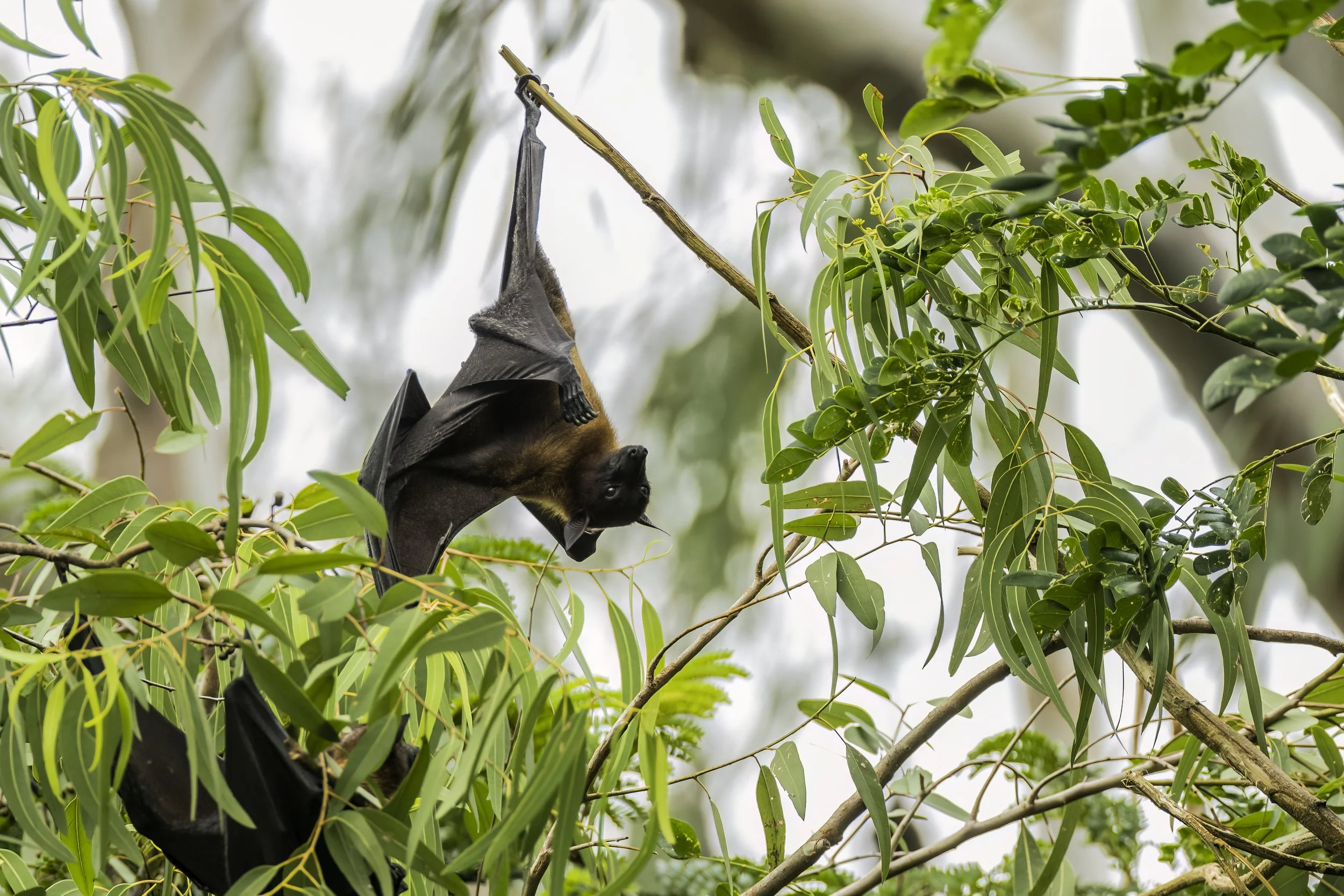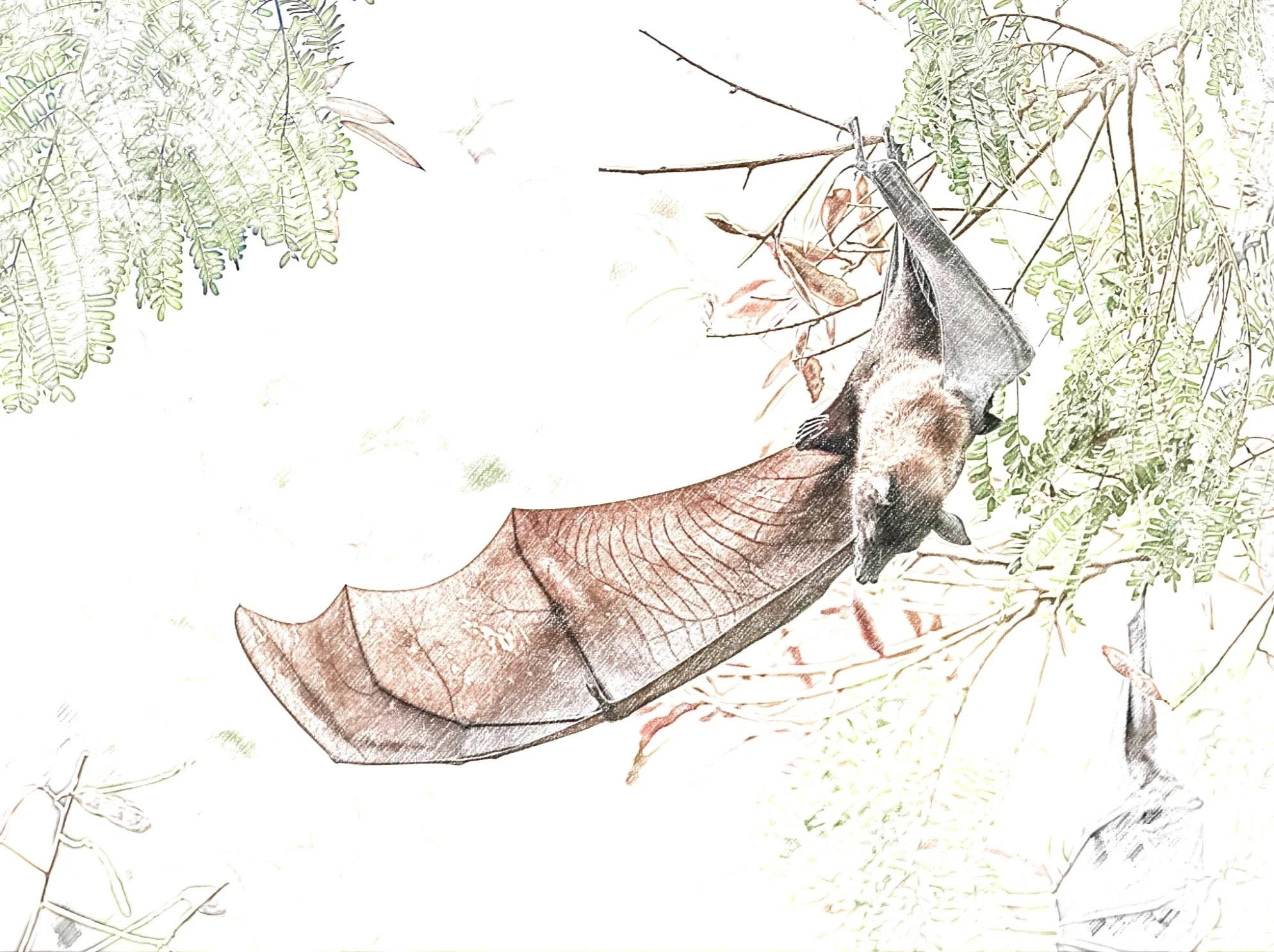Indian Flying Fox/ Greater Indian Fruit Bat
Pteropus medius, formerly Pteropus giganteus
Manjeera Wildlife Sanctuary, Telangana
Today is about a mega bat - the Indian Flying Fox also known as the Greater Indian Fruit Bat.
Of the many species of mammals found across the world, bats constitute one of the major taxa. In peninsular India alone these make up for more than a quarter (120+ species) of the mammalian specie found in the subcontinent. Despite this fact, it’s a paradox that these flying mammals are among the least known and often despised species. Much of the acrimony towards these maligned creatures are perhaps owed to their unaesthetic appearances and uncanny habits. Their nocturnal nature & the fact that several myths mar their reputation has made it difficult to appreciate them. They have always been depicted as vampires or evil creatures in novels and movies the world over.
Bats are magisterial creatures with Goliath-like wings and have various epithets attached to them – blood-sucking vampires, carriers of bad omen, and most recently spreaders of a lethal disease, Covid-19. There is no scarcity of folktales and myths that villainize bats. Behind these veils of myths and superstitions that adorn the bat exists a majestic mammal that plays an integral role in our ecosystem. Yet, due to their unfair reputation, bats are slowly disappearing, teetering on the edge of extinction. Bats are the only mammals equipped to fly (not glide), though they lack the hollow skeletal structure and feathers of birds. They have a thin stretchable membrane between their legs and fingers called webbings and these webbings give them the ability to have a functional wing and a genuine flight. The wings of bats are very thin compared to birds which allows them to manoeuvre with precision. Since the wing membranes are very thin they are also prone to tears, but have the ability to repair and heal themselves. The first and most pivotal step to conserve these majestic animals is to familiarize ourselves with them, permanently shedding the veil of myth and superstition that shrouds them.
If you travel to parts of southwestern India and ask people what they think of bats, locals may narrate a tale of how bats were once unhappy birds who wished to be human. They slowly began transforming into a human – they got hair, teeth, and a few other mammalian features. Yet the process abruptly stopped, and the creatures remained mostly bird-like. Ashamed of their new and bizarre features, the birds began moving around only at night, hiding their faces during the daylight.
This famous Indian folklore mistakes bats for unhappy birds. In reality though, bats have no relation to birds and are in fact flying mammals! Bats belong to the scientific order Chiroptera, a term with Greek roots meaning cheiro (hand) and ptera (wing), indicating the similarity of their batwing to a hand. Like most mammals, they too are warm-blooded and have fur covering their bodies.
Some species of bats are suspected to have existed even before humans. Evidence of their existence has been found from about 50 million years back during a time known as the Eocene. Also, at the risk of disappointing Dracula fans, bats do not feast on human blood. What a bat eats varies according to its specific species and family. Bats belonging to the category of Megachiroptera are mostly fruit-eating bats. For example, the Indian Flying Fox, our focus today and the largest flying mammal in India, sustains itself primarily on fruits and sometimes flowers and pollen. Bats in the Microchiroptera category mostly feed on insects. These bats even feast on mosquitos, eliminating the real blood-suckers of the world! Bats rarely even bite humans, let alone turn us into vampires! Despite their threatening appearance, bats are docile creatures more afraid of us than we are of them. The closest they might get to a human is to cross them to get to their food or simply to exit a location.
While a bat bite may not turn you into a vampire, it could transfer certain viruses to you. Thus it is always advised to maintain distance with a bat and never handle a bat unless you are a professional.
The Manjeera Wildlife Sanctuary is situated along the river Manjeera at a distance of 5 km from the quaint town of Sangareddy and about 50 kms northwest of the capital city of Hyderabad. The sanctuary, spread over 20 km², follows the course of the Manjeera River, a tributary of the mighty River Godavari, for 36 kms and is also home to the Manjeera Bird Sanctuary and has a manmade reservoir which provides drinking water to the twin cities of Hyderabad & Secunderabad. It has nine small islands, including Puttigadda, Bapangadda, Sangamadda and Karnamgadda containing extensive marshy fringes, which act as nesting sites for aquatic birds. Additionally, a thick cover of trees provide nesting spots for other birds.
The vegetation found around this freshwater ecosystem is of the dry savannah type and the reservoir supports both submergence & emergent types of vegetation. The periphery is abundantly covered by the plant species of Typha, Ipomoea and Acacia while agricultural fields surround the reservoir and river.
Originally this riverine habitat was developed as a crocodile sanctuary to protect the Vulnerable Mugger Crocodile, a medium-sized broad-snouted crocodile, native to freshwater habitats from southern Iran to the Indian Subcontinent. Today between 400 and 700 crocodiles call this home along with over 70 species of birds, fresh water turtles, prawns, molluscs and various varieties of fish. I have also seen monitor lizards & cobras and am told there are Indian Hares, Wild Boar, Mongoose & Jackals.
By some counts there are over 73 species of birds seen here like the large flocks of common teals, cotton pygmy goose & ruddy shelduck. Upstream is home to a significant number of cranes and bar-headed geese and the native breeders like the Darter, Asian Openbills, Painted Storks, Eurasian Coot and the Black-crowned Night Heron. These I will write about soon too.
On the banks of the Manjeera river, in a village called Kalabgoor, there is a temple, Sri Kasi Vishweshwara temple, that is said to have been constructed some 800 years ago during the glorious reign of the Kakatiyas. The temple like all temples of legend has magnificent architecture and is entirely made of stone, with some standing pillars created out of a single block. The temple is dedicated to the lord Shiva and also houses other gods like Lord Krishna, Ganapati & the goddess Saraswati. There are two other famous temples in the vicinity - Sri Anantha Padmanabha Swamy Temple and Sri Venugopala Swamy Temple. Together these are known as Trikootaalayamu - which translates to “a three shrine complex”.
The sanctuary has an Environmental Education Centre consisting of a museum, a library, and an auditorium where films about birds and animals are shown daily. There are boat services available to take the visitors around the sanctuary for bird watching, with binoculars and books to identify birds provided to visitors. The museum has exhibits depicting the complex biodiversity of the wetlands. The best season to visit this sanctuary is from November to March when major migrant birds nest and breed here. Accommodation for visitors is available at inspection bungalows in the town of Sangareddy, Singur and Sadasivapet.
Read about some of the birds of this sanctuary.
Indian Flying Fox/ Greater Indian Fruit Bat
Bats are broadly classified into two groups, megabats and microbats. Megabats are usually large and live primarily in tropical regions. The megabats (fruit & pollen eating or nectar feeding bats) have well developed eyes and nose and hence use their eye sight and sense of smell to locate fruits and flowers. The microbats (insectivorous bats) are usually smaller than megabats and have small eyes but large ears. Microbats constitute 70% of bat species while megabats constitute most of the remaining 30% species.
The Indian Flying Fox (Pteropus medius, formerly Pteropus giganteus), also known as the Greater Indian Fruit Bat, is a species of flying fox native to the Indian subcontinent. It is one of the largest bats in the world. It is nocturnal and feeds mainly on ripe fruits, such as mangoes and bananas, and nectar. This species is often regarded as vermin due to its destructive tendencies towards fruit farms, but the benefits of its pollination and seed propagation often outweigh the impacts of its fruit consumption. It is of interest as a disease vector, as it is capable of transmitting several viruses to humans.
The Indian flying fox is India's largest bat, and one of the largest bats in the world, weighing up to 1.6 kg. Its body mass ranges from 0.6–1.6 kg, and males are generally larger than females. The wingspan ranges from 1.2–1.5 m (3 ft 11 in – 4 ft 11 in) and body length averages 15.5–22.0 cm. The wings rise from the side of the dorsum and from the back of the second toe, and its thumb has a powerful claw. It has claws on only its first two digits of its wings, with the thumb possessing the more powerful claw, and all five digits of its leg. It lacks a tail.
The Indian flying fox ranges in color, with a black back that is lightly streaked with grey, a pale, yellow-brown mantle, a brown head, and dark, brownish underparts. It has large eyes, simple ears, and no facial ornamentation—a typical appearance for a species of the genus Pteropus. The skull is oval-shaped and the greatest length of the skull is 71–75.6 mm. The orbital rim of the skull is incomplete. The ears lack a tragus or antitragus and are ringed, and the ears range in length from 35–40 mm (1.4–1.6 in) in length.
The Indian flying fox is found across the Indian Subcontinent, including in Bangladesh, Bhutan, India, Tibet, the Maldives, Myanmar, Nepal, Pakistan and Sri Lanka.
It roosts in large, established colonies on open tree branches, especially in urban areas or in temples. It prefers to roost on tall trees with small diameters, especially canopy trees, and prefers to be in close proximity to bodies of water, human residences, and agricultural land. This habitat selection is highly dependent on food availability. For example, many residences within the bat's distribution have outdoor gardens that support its generalist frugivorous feeding habits. This tendency to support a generalist frugivorous diet through habitat selection also leads it to commonly roost in highly fragmented forests, where the variety of plant species allows it to better utilize its feeding habits.
Its populations are constantly threatened through habitat destruction caused by urbanization or widening of roads. Tree roosts are often felled and colonies dispersed. Smaller colonies tend to remain in place longer than larger colonies, as those larger colonies have their roosts felled more quickly.
The Indian flying fox is frugivorous or nectarivorous preferring fruits or blossoms and nectar from flowers. At dusk, they forage for ripe fruit. It is a primarily generalist feeder, and eats any available fruits. Seeds from ingested fruits are scarified in its digestive tract and dispersed through its waste. It is relied on for seed propagation by 300 plant species of nearly 200 genera, of which approximately 500 economically valuable products are produced in India. Nearly 70% of the seeds in Indian flying fox guano are of the banyan tree, a keystone species in Indian ecosystems.
Although initially thought to be strictly frugivorous, it has been observed deliberately eating insects and leaves. The Indian flying fox also eats flowers, seed pods, bark, cones, and twigs. Their diet changes seasonally, with a greater reliance on mango fruits for moisture in the autumn and spring. A species of ebony tree (pale moon ebony tree) provides dietary fiber year-round. Yellow box eucalyptus and Chinese pistache provide necessary carbohydrates, fats, iron, and phosphorus in the winter.
Bats use varied forms of communication like most other mammals do. The microbats have also evolved a more complex system of using ultrasound by producing sonar signals. This form of communication is known as “Echolocation” and bats use these ultrasonic clicks to communicate between each other, to detect prey and also to navigate in flight. The megabats do not use ultrasound to detect their food or to navigate as they posses better vision and olfactory system to detect and identify fruits and nectar.
Like other fruit bats, the Indian flying fox may be a natural reservoir for diseases including certain henipaviruses and flaviviruses. These can prove fatal to humans and domestic animals. Indian flying foxes in India and Bangladesh have tested positive for Nipah virus, a type of henipavirus. Due to human encroachment into their habitats, there is a high risk of spillover infection of Nipah virus from Indian flying foxes to humans. While Nipah virus outbreaks are more likely in areas preferred by Indian flying foxes, researchers note that "the presence of bats in and of itself is not considered a risk factor for Nipah virus infection." Rather, the consumption of date palm sap is a significant route of transmission. The practice of date palm sap collection involves placing collecting pots at date palm trees. Indian flying foxes have been observed licking the sap as it flows into the pots, as well as defecating and urinating in proximity to the pots. In this way, humans who drink the palm sap can be exposed to the bats' viruses. The use of bamboo skirts on collecting pots lowers the risk of contamination from bat fluids. While Indian flying foxes have also tested positive for GBV-D, a type of flavivirus, it is unclear whether this virus occurs in humans or if it could be transmitted by Indian flying foxes.
Despite the Indian government classifying bats as vermin in the Indian Wildlife Protection Act, the Indian flying fox is sacred in India. In the Puliangulam village in India, a banyan tree in the middle of local agriculture fields is home to a colony of 500 Indian flying foxes. The bats are protected by the local spirit "Muniyandi", and the villagers make offerings of bananas and rice to the spirit and the bats.
Many people believe that bats are mere pests that add no value to our world. The reality, however, is that bats are very integral to our ecosystem! Fruit bats, like this Indian Flying Fox, specifically play an indispensable role in seed dispersal and forest regeneration. They disperse seeds that are proven to have higher germination and growth. It was found that three common fruit bats alone help in the pollination and seed dispersal of around 114 species of plants with significant economic and medicinal value! Apart from regenerating forests and pollinating plants, bats also help control the rodent and insect population! A small bat can eat almost 5,000 mosquitos in one night! Further, bats in rural India consume insects that can be detrimental to crops.
With an unfair reputation superseding them, bats are fighting an uphill battle for survival. The large-scale resentment towards bats during the Covid pandemic has led to demands to cull the animal, completely eradicating them from certain localities. In certain areas, people also resort to damaging the roosts of bats to move large bat colonies out of their neighborhoods.
Bats are also hunted for medicinal purposes or as alternative sources of meat. This led to some local populations becoming endangered or extinct. Other local populations of bats have also disappeared with no possible explanation. For example, the Kolar Leaf-Nosed Bat could be found in only two caves in the village of Hanumanahalli in the Kolar district of Karnataka. The bats in both caves have become extinct, and the reason for their extinction is yet to be determined.
Sometimes mundane human activities like the application of pesticides to kill insects also harm bats. Insectivorous bats depend on insects for sustenance, but bats are losing out on their daily food due to pesticides. Other economic activities like granite quarrying also endanger bats by destroying their natural habitats. This forces bats to venture into human-dominated landscapes. While bats quickly adapt to dense human surroundings, they also face threats like injuries due to colliding with buildings and posts. Wildlife SOS has rescued several injured bats from homes and university campuses with injured wings or is simply starved.
The IUCN Red List places the Indian Flying Fox places categorizes it as Least Concerned category. They are considered as pests and carriers of various harmful diseases. One example is the Nipah virus itself. As far as the horticultural and the agricultural sector of India are concerned, the Indian Flying fox is vermin. An estimated 60% of fruits are damaged by the Indian fruit bat regardless of them being ripe or overripe. The Indian Flying Fox population in Maldives was culled to a certain extent in order to protect fruit orchards. A non-lethal alternative to culling is making netting on fruit trees, using lights during night time and placing Singapore Cherry Trees as a means of distraction since the flying foxes are attracted to this variety. Some tribes in India consider the meat of flying foxes a delicacy and even believe that they have medical properties, capable of curing asthma and chest pain. As of 2018 and estimated 24,480 individuals of the Indian Flying Fox were thought to be spread through the subcontinent.
‡‡‡‡‡
Related Posts


